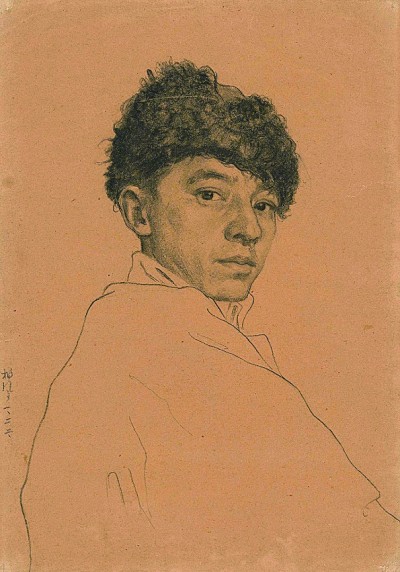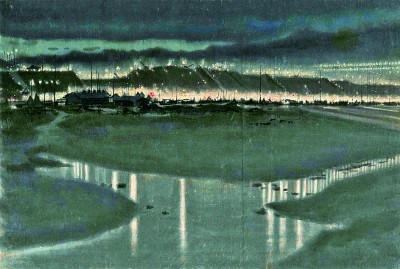【Art Ocean Collection】
Guangming Daily reporter Tian Nei
“Where will it be” is Li Hu’s own title on a small painting. In a large area of blank space, the artist painted a red-clothed little man riding a skinny horse at the bottom right of the picture. This work can be regarded as a question of the times—where is Chinese painting headed? Stepping into the third-floor exhibition hall of Tsinghua University Art Museum, Li Hu’s more than 150 works including ink wash, oil painting, sketch and sketch, seem to be his response to the torrent of the times.
Casting in Front of Furnace (Chinese Painting) Li Hu
In 1933, Li Hu was admitted to Sichuan Provincial Chengdu Normal School. At that time, he had already developed a strong interest in painting. From 1942 to 1946, he studied at the Art Department of Chongqing Central University, where he studied under Xu Beihong, Huang Xianzhi, Lu Sibai, Fu Baoshi, Xie Zhiliu, Li Ruinian and others. He was highly appreciated for his solid modeling skills. In the exhibition hall, the particularly eye-catching “Jialing River Tracker” is one of Li Hu’s representative works during this period. In the picture, several trackers are struggling to move forward, and it seems that they can hear the high-pitched and agitated “Chuanjiang chant” in their ears. At that time, the Jialing River was very busy with transportation, and there was an endless stream of boats and ships coming and going on the river. The boatmen are in groups, paddling along the water and dragging their fibers against the water. Li Hu often sketched landscapes and traveled all over the piers along the river, and finally completed this creation.
It was also during this period that Xu Beihong selected two outstanding students from the Art Department of Central University to attempt to combine Chinese and Western painting. One was Zong Qixiang, who majored in traditional Chinese painting, and the other was Li Hu, who majored in oil painting. In a series of works such as “Strong Plants” and “Refugees in the Flame of War”, Li Hu used ink lines to outline outlines, using both color and ink, and rubbed and smudged to create a sense of structure and volume, reflecting the integration of traditional brush and ink into Western painting modeling techniques idea. In 1946, when Li Hu graduated, he held a personal painting exhibition in Chongqing. Xu Beihong wrote: “Using Chinese paper and ink to sketch life with Western painting methods, it was created after the art department of CUHK moved to Shu, and Li Hu’s younger brother is the most successful one. It can be seen from this that Li Hu has made great efforts in combining Chinese and Western paintings in Chinese painting.

Self-Portrait (Sketch · 1950) Li Hu
At the call of Xu Beihong, Li Hu came to Peiping from Chongqing in 1948, and then taught in the Department of Architecture and Architecture of Tsinghua University, where he was highly valued by Liang Sicheng. Li Hu’s creative vision has also undergone tremendous changes with the migration of the north and the south and the founding of New China. “Looking at the Drawings”, “Casting in Front of the Furnace” and a series of works depicting the Changxindian factory, incorporate workers, factories and other themes that show social production and life into the creation; People’s enthusiasm for supporting the revolution is fully revealed; “Portrait of Guan Zhaoye” has always been treasured by the person in the painting, and it carries Li Hu’s care for students when he was a teaching assistant. In addition, the teaching materials such as sketch plaster statues and figure anatomy diagrams used by Li Hu during his teaching also reflect the modern turn of his art teaching. These practices of integrating Chinese and Western styles highlight his superb modeling ability and his ideal of “making art for the sake of life”.
The modern transformation of Chinese painting in the 20th century showed significant changes in the creative paradigm. Scene sketching has become an important painting method, and sketching and sketching have become important steps in creation. The typical paradigm from sketching to creation is still continuing in the teaching system of major art colleges. In 1958, Li Hu, who was teaching at the Central Academy of Fine Arts, received a letter to create a huge portrait in memory of Guan Hanqing, and his work was finally adopted. In one corner of the exhibition hall, three “Portraits of Guan Hanqing” with different scales and depictions are just the foreshadowing for this. In addition to trying to use line drawing and flat painting to create, Li Hu also started with the human body structure, light and shadow, perspective, etc., and deeply explored the grasp and expression techniques of Guan Hanqing’s divine form, and completed the sketch. Although the huge portrait is nowhere to be found today, from sketches to color ink drawings to gridded line drawings for enlargement, we can still see his work from sketches to ink paintings, from traditional figure paintings to modern figure paintings, Exploration from small manuscripts to large-scale creations.

Night View of the Ming Tombs Reservoir Construction Site (Chinese Painting) Li Hu
Li Hu often went to the countryside and construction sites to sketch from life, and made portraits of laborers. He also often used family members and characters on the stage as prototypes in his creations, reflecting the artistic changes in life. While paying attention to the expression of the figure’s form and spirit, he also emphasized the blending of ink and color, and gradually established a unique method of observation and expression in Chinese painting, which not only maintains the subtlety of form, but also achieves a certain harmony in the collision of ink and color.
In addition to innovations in figure painting, Li Hu changed the insufficiency of traditional ink and wash to express night scenes in the creation of landscape paintings, and created a large number of unique night scene landscape paintings by drawing on Western methods. From “Night Battle” and “Night View of the Ming Tombs Reservoir Construction Site” created by him in the 1950s to “Night Voyage through the Three Gorges” in the 1970s, it can be seen that he no longer taboos shadows and black ink, but uses brand-new brush and ink The form depicts spatial layers and complex and changeable light and shadow effects, praising the great rivers and mountains and construction achievements of New China. Without the expressive technique of sticking to the mustard seed garden style, this extremely rare form can be described as “the brush and ink should be at any time”.
In his short life of 56 years, Li Hu’s artistic creation has always been closely related to social change and the modern transformation of Chinese painting. Even when he was bedridden, he still wrote the words “Aspirations in mind, and difficulties near and far” and hung them on the wall to encourage himself. In 1974, he created his last work. In this sketch self-portrait, although his face is emaciated, his spirit is clear. Facing it directly is an encouragement to oneself, a monologue of life, and a question to oneself.
“Guangming Daily” (version 09, May 7, 2023)
[
责编:张倩 ]
